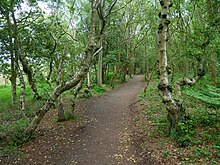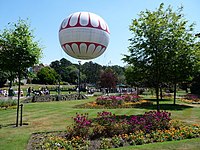
Withybed Wood is a small, yet important patch of woodland located in the lee of Warren Hill, part of Hengistbury Head, Dorset. It is not to be confused with an area of the Wyre Forest in Shropshire, which also has the same name.
Description[edit]
Part of Hengistbury Head Local Nature Reserve and the Christchurch Harbour Site of Special Scientific Interest,[1] the wood has developed immediately north of the archaeologically and environmentally[2] significant Warren Hill, sheltered from the sea breezes coming from the south and west over Poole Bay.
Despite its relatively small size; Withybed is of historic and natural interest; it is the only woodland area shown on an 1811 Ordnance Survey map of the Bournemouth/Christchurch region (the wildlife community also suggests that the woodland could be classified as "ancient semi-natural"),[2] and because of its unique location, lying at the landfall and departure point for birds and other flying animals using the important Cherbourg - Avon valley migration route.[3]
Flora and fauna[edit]

Withybed Wood is home to a variety of tree species including downy birch, English oak and white poplar.[3] Bluebells carpet the western fringe of the wood; foxglove and violets can be seen in the sunnier parts.[4]
The trees at Withybed support various invertebrates, most visibly the butterflies, like the purple and green hairstreak or the speckled wood.[3][4]
A recent bird census showed that the tawny owl, green woodpecker and sparrowhawk breed here either regularly or occasionally. Withybed is also home to, or visited by, the goldcrest[5] the chiffchaff and blackcap amongst others.[3]
See also[edit]
References[edit]
- ^ Hengistbury Head Nature Reserve website.
- ^ a b Bournemouth Borough Council, Hengistbury Head Action plan, 2005
- ^ a b c d Bournemouth Council Hengistbury Head Management plan, 2011(draft)
- ^ a b Woodland of Hengistbury Head Nature Reserve. Hengistbury Head Supporters Group website.
- ^ Website of the Christchurch Harbour Ornithological Group

Well, that’s interesting to know that Psilotum nudum are known as whisk ferns. Psilotum nudum is the commoner species of the two. While the P. flaccidum is a rare species and is found in the tropical islands. Both the species are usually epiphytic in habit and grow upon tree ferns. These species may also be terrestrial and grow in humus or in the crevices of the rocks.
View the detailed Guide of Psilotum nudum: Detailed Study Of Psilotum Nudum (Whisk Fern), Classification, Anatomy, Reproduction